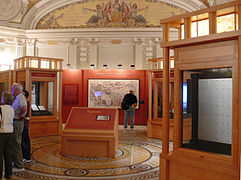Library of Congress
| Library of Congress | |
|---|---|
  Library of Congress logo (top) and emblem (bottom)
|
|
| founding | 1800 |
| Duration | 164 million media units |
| Library type | National Library |
| place |
Washington, DC |
| ISIL | US DLC |
| operator | state |
| management | Carla Hayden |
| Website | www.loc.gov |
The Library of Congress ( LoC , German Library of Congress ) is the publicly accessible research library of the Congress of the United States . It is located in several buildings in Washington, DC The LoC is the second largest library in the world in terms of media inventory, the largest library in the world in terms of book inventory, and one of the most important overall.
The LoC works closely with the Congressional Research Service (also Congress's think tank ).
meaning
With more than 164 million media units, it is the second largest library in the world . Only the British Library in London houses an even larger collection with 170 million media. The holdings of the Washington library include more than
- 38.8 million books and other printed matter in 470 languages,
- 70.6 million manuscripts ,
- 17.1 million microforms ,
- 14.2 million photographs ,
- 8.1 million scores
- 5.5 million plans and maps,
- 3.6 million sound recordings,
- 1.8 million films,
- 0.6 million prints and drawings,
- 0.1 million posters,
- 3.3 million other objects.
The Library of Congress is home to the largest collection of rare books in North America, including a Gutenberg Bible , the Lincoln Bible and Adolf Hitler's book collection, and archived all tweets from 2006 to 2017. The LoC catalog is an important bibliographic resource for university libraries .
history
It was founded as the research library of the US Congress on April 24, 1800 after President John Adams moved the seat of government from Philadelphia to Washington D.C. Since 1802 its administration has been incumbent on the United States Congress Joint Committee on the Library . A $ 5,000 donation was made to purchase books for the use of Congress and to set up space in the new Capitol . The library had grown to about 3,000 volumes when it was destroyed by flames in the August 1814 British-American War during the Washington fire . Thomas Jefferson then offered Congress to buy his private library as a replacement. In 50 years he had compiled almost 6,500 books on philosophy, literature and science in various languages. This diversity went well beyond the scope of the original collection. Even so, Congress approved the purchase of the collection for $ 24,000, thereby laying the foundation for a national library . Jefferson's belief that all issues matter to American law remains the rationale of the Library of Congress today.
On December 24, 1851, a fire destroyed 35,000 books and other furnishings, including an original portrait of Christopher Columbus . Later, the library was able to expand its holdings significantly as a depositary for the copyright protection of works. If you wanted to protect your work under American copyright law, you had to give two copies of your work to the library free of charge. This regulation was transferred to the newly founded patent office in 1859. This fact, and a devastating fire that destroyed two thirds of the holdings at the time, put the Library of Congress in serious financial difficulties. Ainsworth Rand Spofford regained the copyright deposit in 1864 and secured financial support for the library from both congressional parties. So it could be expanded significantly under his leadership.
In 1906 the foundation stone was laid for the Russian collection of the Library of Congress with the purchase of the 80,000-volume private library that the Siberian merchant, book lover and collector Gennady Wassiljewitsch Yudin had assembled in Krasnoyarsk .
The library budget is still largely provided by the Congress. There are also three representative buildings to be maintained in Washington D.C.
The buildings
The three buildings are characterized by very different architecture. They are located on Capitol Hill and are connected by an underground tunnel system. On December 21, 1961, the Library of Congress was granted National Historic Landmark status.
The Italian Renaissance-style Thomas Jefferson Building was inaugurated in 1897 and has long been the main library building. The grand entrance hall is made of marble. The main reading room with its imposing cupola, as well as other special reading rooms and a concert hall are located in the building. The John Adams Building was occupied in 1938 and today houses the book magazine and a second large reading room. Art Nouveau elements determine the architecture. The James Madison Memorial Building , inaugurated in 1980, a sober six-storey building, houses the magazine department, administration, computer department and various special departments. More than 4,000 employees work in the buildings, including both professional librarians and academics in their specialist fields. Other large magazines outside the city are also part of the library.
The Library of Congress Classification
After working according to the system that Thomas Jefferson had created for his collection in the first decades, Herbert Putnam created the Library of Congress Classification, a classification that is still used today by most university libraries and research institutions in the USA.
The intended inventory number LCCN for the Library of Congress is already printed in the imprint of many books.
Librarians of Congress
The directors of the Library of Congress, the Librarians of Congress (German: Kongressbibliothekare ), are appointed by the US President and confirmed by a vote of the Senate . The previous Librarians of Congress:
- John James Beckley (1802-1807)
- Patrick Magruder (1807-1815)
- George Watterston (1815-1829)
- John Silva Meehan (1829–1861)
- John Gould Stephenson (1861–1864)
- Ainsworth Rand Spofford (1864-1897)
- John Russell Young (1897-1899)
- Herbert Putnam (1899-1939)
- Archibald MacLeish (1939–1944)
- Luther H. Evans (1945–1953)
- Lawrence Quincy Mumford (1954–1974)
- Daniel J. Boorstin (1975–1987)
- James Hadley Billington (1987-2015)
- Carla Hayden (2016–)
Others
Every fall, the library hosts the National Book Festival , each with around 100,000 visitors.
The library's sound project started in May 2011 is the National Jukebox .
photos
LoC homepage: Government Shutdown 2013
literature
- John Y. Cole (Ed.): Encyclopedia of The Library of Congress . Washington, DC 2004. ISBN 0-89059-971-8
See also
- Library of Congress Country Studies
- National Library of Medicine
- National Archives and Records Administration
Web links
-
Official website (English)
- Online catalog - media lookup
- Library of Congress Authorities - People Look Up
- Photo stream from The Library of Congress on flickr
- The Library of Congress as a 3D model in SketchUp's 3D warehouse
Individual evidence
- ^ General information about the library
- ^ The Lincoln Bible . In: World Digital Library . 1853. Retrieved September 2, 2013.
- ^ Hitler's book collection
- ↑ Too big for the US Library of Congress. tagesschau.de, December 27, 2017
- ^ "So Ample a Collection, So Well Balanced:" The Yudin Collection at the Library of Congress ( en ) 2015. Retrieved June 5, 2015.
- ↑ Listing of National Historic Landmarks by State: District of Columbia. National Park Service , accessed July 19, 2019.









